For the purposes of this report, mobility is broken into three groupings: mobility to and within a theater, logistics over the shore, and mobility ashore. Most of the intertheater mobility assets are owned by the Air Force and the Navy. The majority of materiel moved into a theater and operational area will be moved by sea. In the realm of intratheater transportation, the Army has assets that can be used in addition to the available Air Force and Navy assets. Army assets will become more dominant in the ship-to-shore regime. There are a number of Army and commercial watercraft for moving materiel to the shore. Finally, the movement of material once ashore to the operational area will be handled by Army and Defense Logistics Agency assets.
The challenges of not having a port in the area of operations were demonstrated by the U.S. experience in Afghanistan, which is landlocked. It has therefore been necessary to rely on complex overland and air networks from distant ports. These are vulnerable to political disruptions in addition to more conventional military threats. The spread of anti-access/area-denial (A2/AD) technologies, strategies, and tactics makes logistics operations riskier and more difficult. For instance, in hostile areas, the Department of Defense (DoD) plans for ships to lay at least 25 miles offshore and offload their contents to various connectors—smaller watercraft—that will then make the run in to shore (CBO, 2007). Once at the shore, it is possible that there will be no port, or that a port will be inadequate to move the necessary materiel ashore, resulting in a reliance on lighterage and causeway systems or on connectors that can beach themselves or move over the beach.
Thus, improvements in mobility could produce significant benefits for sustainment operations. Improved vessels could move more supplies more quickly to and within the theater. Improved connectors could do the same for the movement of materiel from ship to shore. Current systems would take several hours to transit from ship to shore, offload, and then return to the ship. There are technologies that could be used for the final transportation legs, to a forward logistics base and then to the forward troops, that would take personnel out of harm’s way.
MOBILITY INTO THE THEATER AND WITHIN THE THEATER
Each contingency operation brings with it unique challenges. The Army’s initial reaction forces in a contingency would probably draw on theater prepositioned stocks, APS-3 (Afloat).1 Based on the requirements dictated by the supported combatant commander, follow-on forces would flow into the theater according to the time-phased force and deployment data.
U.S. Army Field Manual FM 100-17-3 outlines the processes for forward movement of forces in response to crisis contingencies, including combat operations (DA, 1999). It points out that while most of the troops will deploy by air, 90 percent of their equipment and vehicles will deploy by sea due to weight considerations. While prepositioned stocks may be available to support initial operations, the sustainment of operations will require establishment of a sea bridge. The sea movement of equipment and supplies is
________________________
1 These are equipment and sustainment supplies prepositioned afloat on ships for rapid access and use in event of need.
entirely dependent on having access within the theater of operations to adequate port facilities to offload or transload the inbound materiel. The overall force projection process is shown in Figure 4-1. Forces and materiel move from home stations in the United States to air- and seaports of embarkation. From there they can move to intermediate staging bases, depots, or directly to air- and seaports of debarkation. At this stage personnel can be married up with prepositioned materiel. From there they move to the fight. Figure 4-2 shows the same process using the strategic mobility triad of air transport, sea transport, and prepositioned materiel in a simplified form.
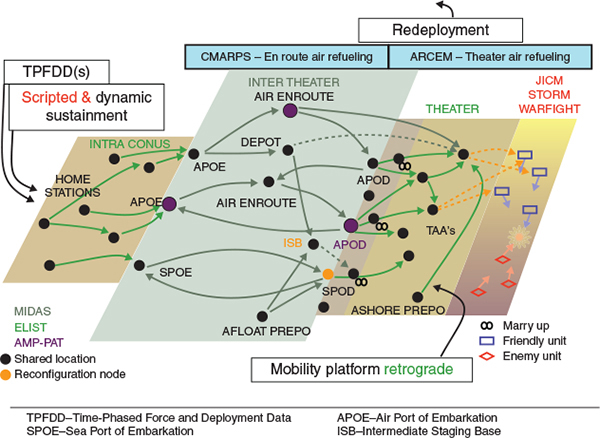
FIGURE 4-1 MCRS-16, modeling and simulation overview of the flow of forces and materiel from the United States to an overseas contingency. NOTE: AMP-PAT, Analysis of Mobility Platform—Port Analysis Tools; APOD, airport of debarkation; APOE, airport of embarkation; ARCEM, Air Refueling Combat Employment Model; CONUS, continental United States; CMARPS, Combined Mating and Ranging Planning System; ELIST, Enhanced Logistics Intratheater Support Tool; ISB, intermediate staging base; JICM, Joint Integrated Contingency Model; MIDAS, Model for Intertheater Deployment by Air and Sea; PREPO, prepositioned; SPOD, seaport of debarkation; SPOE, seaport of embarkation; TAA, tactical assembly area; TPFDD, time-phased force and deployment data. SOURCE: Jackson (2009).
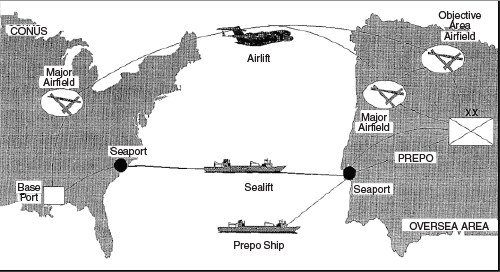
FIGURE 4-2 The strategic mobility triad. NOTE: CONUS, continental United States; PREPO, prepositioned. SOURCE: U.S. Army, Movement Control, Field Manual No. 55-10, Headquarters, Washington, D.C., February 1999, available at http://www.globalsecurity.org/military/library/policy/army/fm/55-10/ch1.htm.
For air movement to theater, the Air Force has a fleet of 223 C-17s and a varying number of C-5 aircraft to move large quantities of materiel quickly.2 When speed is imperative for the initial deployment, the C-17 has the unique ability to go from a major airfield into semi-improved airfields. In November 2001, C-17s landed in the dark on a dirt runway at Camp Rhino in Afghanistan, delivering 481 Marines and 970 short tons of equipment over 8 days. It was the first-ever C-17 combat dirt landing using night-vision goggles (Young, 2011).
The Air Force C-17 and C-5 fleet is part of Air Mobility Command and operates at the direction of the U.S. Transportation Command’s (TRANSCOM’s) Tanker Airlift Control Center. The Director of Mobility Forces is the key to execution of the support for U.S. Army theater operations. The execution phase is controlled by the Airlift Control Team and the Air Mobility Control Team. According to a U.S. Air Force Fact Sheet on the Air Mobility Division,3
Airlift Control Team (ACT) provides intra-theater airlift functional expertise from the theater organizations to plan, coordinate and integrate the full range of mobility airpower capabilities at the operational level for intra-theater airlift operations in the area of responsibility. Airlift Plans is responsible for completing the airlift portion of the air tasking order by processing validated airlift requests received… and merging them with forecast inter-theater airlift movements into the area of responsibility.
…Air Mobility Control Team (AMCT) provides Combat Air Operations Center (CAOC) centralized control of all intra-theater airlift operations in the AOR. The AMCT directs or
________________________
2 The total number of C-5s in the fleet changes monthly. This number is based on congressional approval of C-5A retirements. 52 C-5Ms are scheduled to be in service by FY2017 and 16 had been delivered as of December 31, 2013 (U.S. Air Force, “C-5 A/B/C Galaxy and C-5M Super Galaxy,” published May 15, 2006, http://www.af.mil/AboutUs/FactSheets/Display/tabid/224/Article/104492/c-5-abc-galaxy-c-5m-super-galaxy.aspx).
3 U.S. Air Forces Central Command, “Air Mobility Division (AMD),” Fact Sheet, published September 8, 2009, www.centaf.af.mil/library/factsheets/factsheet_print.asp?fsID=12153&page=1.
redirects, as required, air mobility forces in concert with air and space forces to respond to requirement changes, higher priorities, or immediate execution limitations. The AMCT integrates and synchronizes all air mobility operations into, out of, and within the AOR. The AMCT maintains execution process and communications connectivity for tasking, coordinating and flight following with the CAOC’s Combat Operations Division, subordinate air mobility units, and mission forces.
For intratheater airlift and support, the Air Force has C-130 aircraft. The Army has a fleet of helicopters.
Before discussing sealift and operations from ship to shore, it should be noted that the capabilities of various assets to conduct operations are impacted and limited by sea state. While sea state is widely used to express the harshness of conditions, it is not of itself adequate to express the full impact of rough seas. Nor does it take into account surf, which will impact sea systems such as causeways. Surf conditions are greatly affected by the state of the tide, swells, coastal currents, and wind strength. These impacts are not taken into account by “sea state.” Sea state and surf are discussed at more length in Appendix D. As mentioned below in a number of places, many systems are designed to be usable only in sea states up to 2. Table 4-1 shows the percentage of time various littoral areas experience seas states of 3 or less. The corollary is that the remainder of the time, sea states are greater than 3.
The committee was briefed on a variety of sealift assets to address the movement, offloading, and transfer of materiel from the sea. The movement of a moderate-sized force into a semiaustere environment can be facilitated by the use of large, medium-speed, roll-on/roll-off ships (LMSRs), operated by the Military Sealift Command. A current-model LMSR has a cargo space of over 380,000 ft2 and can carry a force of 58 tanks, 48 tracked vehicles, and more than 900 trucks and other wheeled vehicles. Internal ramps, a stern ramp, and removable side ramps facilitate the flow of vehicles within and the offloading of vehicles from the vessel to causeways and other receiving areas. An LMSR also has two cranes, allowing it to load and unload cargo onto a dock or causeway or into smaller vessels alongside in the absence of adequate port infrastructure.4 Sea state can be a limiting factor in these operations.
TABLE 4-1 Percentage of Time Different Littoral Areas Experience Sea State 3 or Less
| Littoral Area | Percent of Time | Littoral Area | Percent of Time |
| Western Atlantic | 60 | Mediterranean Sea | 75 |
| Eastern Atlantic | 40 | Persian Gulf | 89 |
| North Sea/English Channel | 52 | North Arabian Sea | 73 |
| Eastern Pacific | 45 | West Indian Ocean | 52 |
| Western and Southern Caribbean | 53 | Cape of Good Hope | 21 |
| Northeast South America | 54 | Gulf of Guinea | 71 |
| Western South Atlantic | 43 | Northwest Africa | 48 |
| Eastern South Pacific | 40 | East coast of Japan | 48 |
| Northwest South America | 55 | East coast of Philippines | 62 |
| Western Central America | 73 | Korean coast | 71 |
SOURCE: DSB (2003).
Another asset is the Joint High Speed Vessel (JHSV), which will be operated by the Navy. In addition to providing intratheater transport, the JHSV will act as a connector between a sea base or a
________________________
4 U.S. Navy, “Large, Medium-speed, Roll-on/Roll-off Ships T-AKR,” last update August 31, 2009, http://www.navy.mil/navydata/fact_display.asp?cid=4600&tid=500&ct=4.
mobile landing platform (MLP), discussed below, and the shore (port, causeway, or beach).5 In an A2/AD environment (no available port), the JHSV is designed to be self-sustaining and operate in austere and degraded environments. These ships are wave-piercing catamarans, run at 35-40 knots, and have a 1,200 mile range, a 600 ton capacity, and a 20,000 ft2 mission bay. The JHSV can be quickly reconfigured to support a variety of missions. These missions can range from carrying hospitals or supplies for humanitarian relief missions, to transporting combat units and their equipment, including tanks and other vehicles. Ten are being built, with the last to be delivered in 2017.6
The MLP is a new addition to the nation’s sealift capabilities. Its purpose is to facilitate the transfer of materiel from sea vessels to the vessels that will carry it to shore. The USNS Montford Point (T-MLP-1), the first of three vessels of this class, entered service in May 2013. The MLP is 785 ft long and displaces about 80,000 tons fully loaded. It is able to partially submerge. This allows the operation of various landing craft, including the landing craft air cushion (LCAC), from the deck. The MLP has 25,000 ft2 of stowage space for vehicles and equipment and can store 380,000 gal of JP-5 naval aviation fuel. It has a top speed of 15 knots and a range of 9,500 nautical miles.7 The third MLP will be modified as an Afloat forward staging base (AFSB).8 An AFSB has decks, including a flight deck, and repair facilities and is able to support a variety of operations. Over the next 5 years, the Navy will field 2 MLPs, 2 AFSBs, and 10 JHSVs.9 The combination of the LMSR, the JHSV, and the MLP/AFSB will provide the Army with the ability to operate in the austere environment of the Pacific. Figure 4-3 depicts an LMSR alongside, and transferring cargo to, an MLP.
Finding 4-1. There is a critical need to enhance the ability to deploy and sustain Army units and their heavy equipment to austere environments using a variety of vessels and platforms. This necessitates that Army leadership support expansion and rapid execution of the current and follow-on programs.
Recommendation 4-1. The Army should continue to work with the Navy to bring the synergy of the large, medium-speed, roll-on/roll-off ship; the Joint High Speed Vessel; and mobile landing platform together into an operational system to enhance its flexibility in responding to contingency operations. This necessitates that Army leadership press forward on achieving closure in this area by continued involvement in the U.S. Navy 30 year ship building program and pursuing congressional funding to execute procurement of these vessels and programs.
________________________
5 A sea base is one or more ships standing offshore serving as staging points for the delivery of personnel and materiel to the shore.
6 U.S. Navy, “PEO Ships Joint High Speed Vessel (JHSV). Program Summary,” http://www.navsea.navy.mil/teamships/PEOS_JHSV/default.aspx, accessed August 25, 2014.
7Naval-technology.com, “Mobile Landing Platform (MLP) Ship, United States of America,” http://www.navaltechnology.com/projects/mobile-landing-platform-mlp-ship, accessed August 25, 2014.
8 General Dynamics NASSCO, “Mobile Landing Platform Fact Sheet,” August 5, 2014, http://www.nassco.com/products-and-services/usn-dc/usn_dc_pdfs/MLP_Fact_Sheet.pdf.
9 U.S. Navy, “CNO’s Navigation Plan 2014-2018,” http://www.navy.mil/cno/130813_CNO_Navigation_Plan.pdf, accessed August 25, 2014.
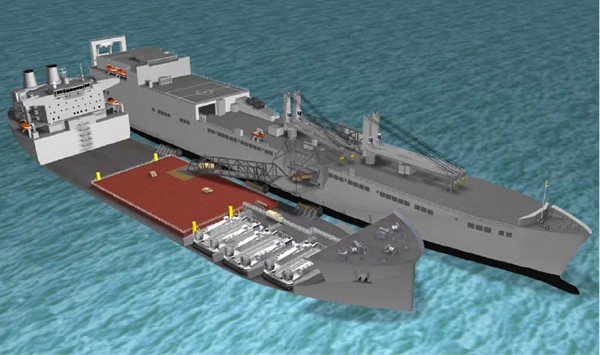
FIGURE 4-3 Artist’s concept of an LMSR alongside, and transferring cargo to, an MLP. Note the three landing craft air cushions (LCACs) on the MLP. SOURCE: CAPT Henry Stevens III, Strategic and Theater Sealift Program Manager, PMS 385, “Joint High Speed Vessel (JHSV) and Mobile Landing Platform (MLP) Program,” presentation to the Expeditionary Warfare Conference on October 27, 2011.
The Army plays an important role in moving waterborne cargo from ship to shore. To carry out these connector missions, the Army employs a variety of craft. In the absence of access to deepwater port facilities, material must move from oceangoing ships to inland points by moving over the shore, into estuaries, up rivers, or through underdeveloped ports. This is done using landing craft and causeway systems. For expeditionary forces, the traditional way of putting troops and material ashore also has been landing craft. The main classes of Army hull-borne landing craft are shown in Table 4-2.
Figure 4-4 shows a landing craft, mechanized (LCM)-8, Figure 4-5 shows a landing craft, utility (LCU)-2000, and Figure 4-6 shows an LSV.
The speeds of all of the hull-borne landing craft are in the 9-12 knot range. If they were to be used as connectors to ships lying a considerable distance offshore (over the horizon), their slowness would be a great detriment to any logistical effort. Also, the LCM craft have very limited capacity. Even the LCU craft lack sufficient capacity as the weight of Army and Marine Corps equipment has grown over time. The LCU-2000 can accommodate five M1 tanks or 29 20 foot containers. Also, the LCU and LCM craft are flat-bottomed and sensitive to sea state and surf conditions. Over the past two decades the Army’s focus has been on the Middle East and not on a maritime or littoral environment. With the pivot to the Pacific, the importance of being able to move material and personnel quickly by water and over the shore looms large.
Finding 4-2. The landing craft currently in the inventory are an impediment to efficient logistics in the Asia-Pacific theater. They are aged, slow, have insufficient capacity, are too few in number, and are highly sensitive to sea state.
TABLE 4-2 Main Classes of Army Hull-Borne Landing Crafta
| Class | Number | In Service | Payload (short tons) | Range (nautical miles) | Speed (knots) |
| Landing craft mechanized, LCM-8 (Mod. 1) | 9 active Army | 1967 | 53 | 271 | 9 |
| 9 Army reserve | |||||
| 18 prepositioned | |||||
| Landing craft utility, LCU-2000 | 7 active Army | 1990 | 350 | 6,500 | 10 |
| 7 Army reserve | |||||
| 20 prepositioned | |||||
| Logistics support vessel (LSV) | 5 active Army | 1988 | 2,000 | 6,500 | 11.5-12 |
| 3 Army reserve | |||||
a Range and speed are when loaded.
SOURCE: CW4 Walter Ortiz, Marine Deck Officer, and CW4 Jennifer Trossbac, Marine Engineer Officer, “U.S. Army Watercraft Quick Reference Cards,” TRADOC, undated.
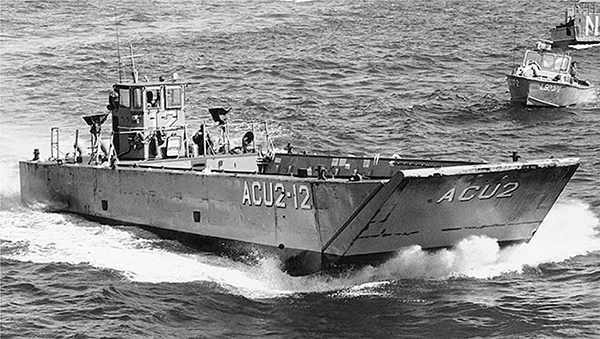
FIGURE 4-4 LCM-8. SOURCE: U.S. Navy photo via Wikimedia Commons, http://commons.wikimedia.org/wiki/, File: Lcm-8_1972.jpg#filelinks.
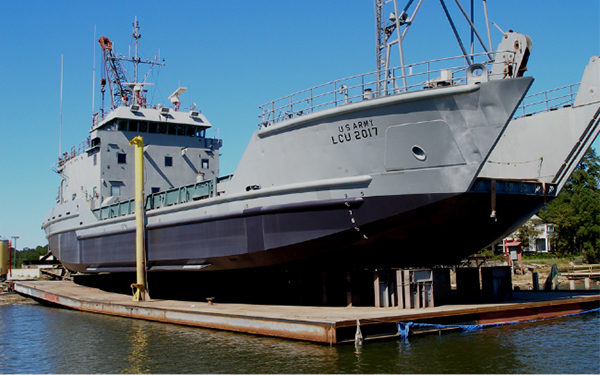
FIGURE 4-5 LCU-2000. SOURCE: Courtesy of Metal Trades, Inc., http://metaltrades.com/customerprofiles/u-s-army.
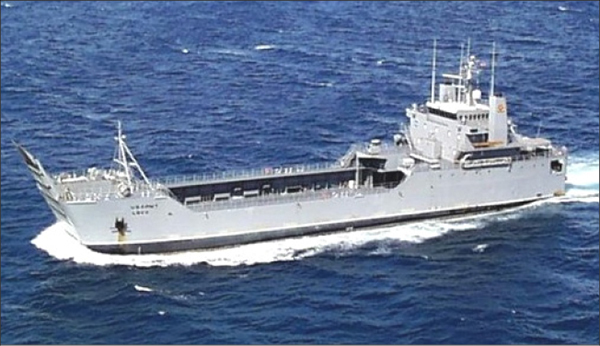
FIGURE 4-6 Logistics Support Vessel. SOURCE: CW4 Walter Ortiz, Marine Deck Officer, and CW4 Jennifer Trossbac, Marine Engineer Officer, “U.S. Army Watercraft Quick Reference Cards,” TRADOC, undated.
Maneuver Support Vessel to Replace Army Landing Craft
The Army is currently working on developing the maneuver support vessel (MSV) to replace its aging hull-borne landing craft. There will be three versions of the MSV. A light version will replace the LCM-8. It will carry a platoon-size combat-configured force element—for example, one M1 Abrams or two Strykers. A medium version will replace the LCU-200 and will carry a company-size combat-configured force element. A heavy version will replace the LSV and will carry a battalion-size combat-configured force element—for example, 36 M1 Abrams or 60 Strykers. They are all to have a shallower draft than the vessels they will replace, and all will be capable of beaching, either in assault operations or to deliver materiel to unimproved locations lacking port facilities. Table 4-3 summarizes the planned capabilities of the MSV, and Figure 4-7 shows an artist’s conception of that craft. As can be seen, all classes are planned to be significantly faster than the vessels they replace. The MSV-Light is currently under development. MSV- Medium and MSV- Heavy development efforts are not yet under way. These improved capabilities would enable the Army to provide support faster and in a wider variety of locations than existing craft. As such they will be important multipliers of logistics capabilities.
Finding 4-3. The three planned classes of the Maneuver Support Vessel are an important step forward in Army landing craft capabilities. It is vital that these improved capabilities be introduced into the Army as soon as possible.
Recommendation 4-2. The Army should proceed with the development of the Maneuver Support Vessel (MSV)-Light with all speed and should proceed with the MSV-Medium and MSV-Heavy concurrently with the MSV-Light.
TABLE 4-3 Planned Capabilities of the MSV, by Classa
| Class | Range (nautical miles) | Speed (knots) |
| Light | 400 | 18 |
| Medium | 5,000 | 25 |
| Heavy | 5,000 | 25 |
a All figures are for craft when loaded.
SOURCE: CW4 Walter Ortiz, Marine Deck Officer, and CW4 Jennifer Trossbac, Marine Engineer Officer, “U.S. Army Watercraft Quick Reference Cards,” TRADOC, undated.
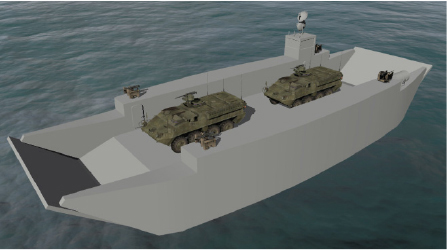
FIGURE 4-7 Artist’s conception of an MSV-Light. SOURCE: CW4 Walter Ortiz, Marine Deck Officer, and CW4 Jennifer Trossbac, Marine Engineer Officer, “U.S. Army Watercraft Quick Reference Cards,” TRADOC, undated.
Another important system for sea-to-shore movement is the LCAC. This is a Navy asset. There are some 79 such craft in inventory, built between 1984 and 2000.10 Each has a payload capacity of 120,000 lb, with an overload capacity of 150,000 in some circumstances. They are 81 feet long by 43 feet wide and have a range of 200 miles. Their speed is dependent on sea state. Their maximum speed, which is only achievable below sea state 2, is 50 knots. Their maximum speed in sea state 2 is 40 knots, and in sea state 3, 30 knots (Polmar, 2013). This is an aging asset with the associated increase in maintenance demands. A service life extension program for 73 LCAC vessels began in 2000 and is scheduled to be completed in 2016. Figure 4-8 shows an LCAC.
Finding 4-4. Existing aging Landing Craft Air Cushion require considerable maintenance, though they are undergoing a service life extension program, and they have limited capacity. Their maximum speed is very sensitive to sea state.
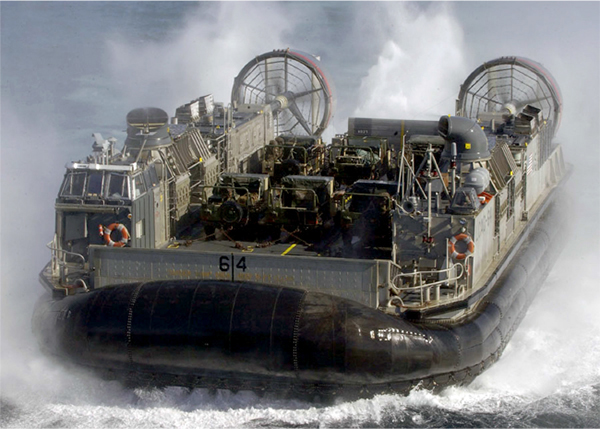
FIGURE 4-8 LCAC. SOURCE: Department of Defense, “LCAC Offload,” DoD photo archive, http://www.defense.gov/transformation/images/photos/2007-01/hi-res/070122-N-1175T-018.jpg.
________________________
10 Capt C.P. Mercer, Amphibious Warfare Program Office, PMS377, “Ship to Shore Connector (SSC): A Turning Point in Naval Ship Design,” presentation on September 9, 2010.
Ship-to-Shore Connector as a Replacement for LCAC
The Marine Corps is currently looking for a new high-speed connector to transport its next-generation equipment ashore. In March 2014, Marine Corps Commandant GEN James Amos observed that sea bases are expected to be 50 to 100 miles from the coast and what is needed is a high-speed connector capable of 25-35 knots. The ship-to-shore connector (SSC) is a new hovercraft program designed to replace the existing 81 LCACs. The SSC will also be an air cushion landing craft, with speeds in excess of 35 knots and an increased load capacity of 74 tons.11 The SSCs will have dimensions similar to the LCACs’ but have been designed for improved performance (e.g., 11 percent better fuel efficiency than LCACs) with less maintenance. It is envisioned that the SSC will shuttle troops and materiel from ships 25 miles from shore. This distance will provide more opportunities for our forces to intercept incoming antiship missiles in response to A2/AD threats. It will be capable of operating in a sea state as high as 3. The program is scheduled to reach initial operational capability in fiscal year (FY) 2020. There are to be five operational craft and one training craft. Figure 4-9 shows an artist’s rendering of an SSC. It should be noted that the French, Chinese, and Russians are building 50 knot air cushion landing craft for expeditionary purposes.
Finding 4-5. The existing ship-to-shore connector acquisition program is targeted to meet the needs of the U.S. Marine Corps, with 72 units planned.
Finding 4-6. The ship-to-shore connector program presents an opportunity for the Army to modernize its landing craft fleet.
Recommendation 4-3. The Army should ensure that its needs are reflected in the ship-to-shore connector acquisition program.
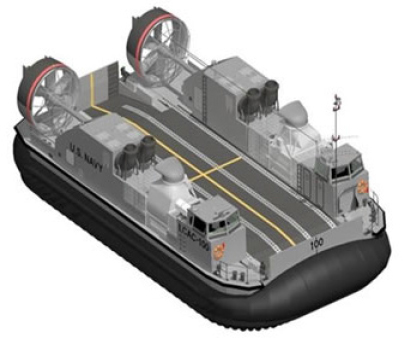
FIGURE 4-9 Artist’s concept of an SSC. SOURCE: U.S. Navy, “PEO Ships Ship-to-Shore Connector (SSC),” http://www.navsea.navy.mil/teamships/PEOS_SSC/SSC_Images.aspx.
________________________
11 Ibid.
For sustained supply when adequate port facilities are lacking, the Army, Navy, and Marine Corps have developed a series of deployable small barges and floats that can be assembled into effective floating causeways, together known as Joint logistics over-the-shore (JLOTS). Figure 4-10 shows JLOTS causeway sections. The intention in using causeways is to allow deep-draft sea vessels to marry to the seaward end of causeways in relatively deeper water. The causeways extend to the shore, through the surf zone, to the beach. All discussion has been about the capability of the systems in sea states at the seaward end of the causeways, where the difficult operation of transferring cargo takes place. The Army systems have been tested and are reportedly capable of operating in sea state 2. The Navy systems are reportedly capable of operating in sea state 3.12 This sea state is typical of that encountered most of the time in tropical and sheltered waters. However there are some questions about whether linkages, fendering systems, and ship ramps are usable in these sea state conditions.
The existing causeway systems will likely perform well in sheltered harbors, river estuaries, bays, and even in the lee of islands. Problems occur when the beach and roadstead are open to the sea; at temperate latitudes, where sea states are higher; and on shallow, shoaling beaches where even small swells can build to sizable surf conditions, often in advance of and after tropical storms. These factors may limit the use of causeways at critical times. A sudden increase in sea state could interrupt unloading operations or cause the loss of causeway components. Additionally, sea states 3 and greater present significant challenges to existing floating causeway systems.
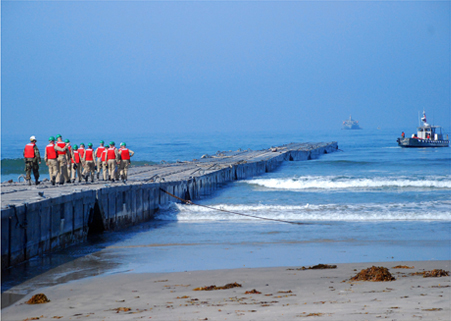
FIGURE 4-10 Deployed JLOTS causeway segments. SOURCE: U.S. Navy photo by Mass Communication Specialist 3rd Class Brian Morales [public domain], via Wikimedia Commons, http://commons.wikimedia.org/wiki/, File: US_Navy_080715-N-4973M028_Midshipmen_walk_along_the_Joint_Logistics_Over-The-Shore_(JLOTS)_Admin_Pier,_an_800-foot_long,_small-craft_pier.jpg.
________________________
12 Committee discussions with Army presenters during Meeting 3 at the U.S. Army Research, Development and Engineering Command, in Aberdeen Proving Ground, Md.
The Navy has developed the innovative elevated causeway system-modular (ELCAS-M). This is essentially a mobile pier system that can be assembled within days of arriving at the site. ELCAS-M has full-size cranes that can be used to offload materiel from vessels. Notably, it can be used where there is no functional port.13 This elevated system was successfully demonstrated in 1995 and was a partial solution to the sea state limitation of the JLOTS floating causeway systems. Figure 4-11 shows the ELCAS-M. The Navy has since placed the improved Navy lighterage system (INLS) into service. The INLS is made up of pontoon sections and can be configured in a variety of ways to provide the ability to move materiel from ship to shore (Defense Industry Daily, 2013). Figure 4-12 shows one configuration of the INLS.
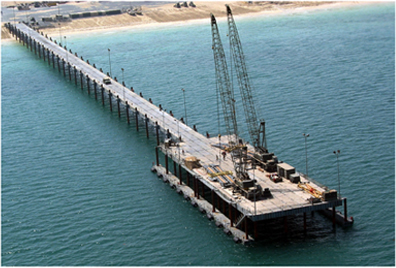
FIGURE 4-11 ELCAS-M in place.
SOURCE: U.S. Navy photo by Journalist 1st Class Joseph Krypel. [Public domain], via Wikimedia Commons, http://commons.wikimedia.org/wiki/,File: US_Navy_030426-N-1050K052_The_U.S._Navy’s_Elevated_Ca useway_System-Modular_(ELCASM)_stands_completed_at_Camp_Pat riot.jpg.
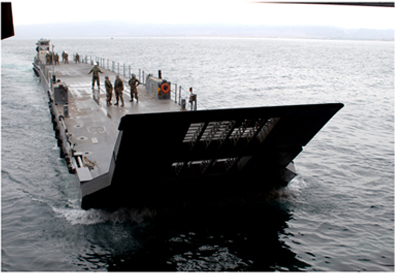
FIGURE 4-12 INLS.
SOURCE: U.S. Navy photo by PO1 Richard Doolin, http://www.defense.gov/homepagephotos/leadphotoimage.aspx?id=3523.
________________________
13 Navy elevated causeway system - modular (ELCAS-M) information available at usfleetforces.blogspot.com/2010/08/navy-elevated-causeway-system-modular.html, accessed August 26, 2014.
The Army Engineer Research and Development Center has developed the innovative lightweight modular causeway system (LCMS). Originally a series of 8 foot wide parallel floats were joined to provide an 80- foot long prototype. Further development has resulted in a very lightweight modular causeway 120 feet long. The LCMS weighs only 90 tons per 80 foot length. A 40 foot section of the LMCS consists of four 6,500 lb modules and has the same footprint as a 20 foot ISO container.14 The causeway deck is supported by inflatable flotation tubes. The causeway can be deployed by seven persons in 3 hours and can support 70 ton vehicles (Resio and Fowle, 2010). These units can be carried on a JHSV and can even be carried by CH-47 Chinook helicopters. Nevertheless, the system still suffers from sea state limitations. TRANSCOM has a science and technology effort under way to develop a system, the Joint universal causeway interface system, to marry up the LCMS and INLS. TRANSCOM also has a roll-on/roll-off interface motion platform motion compensation study under way to permit ramps on commercial ships to interface with the Army modular causeway system. Figure 4-13 shows an artist’s conception of the LCMS in use.
Considerable work may be necessary to allow accurate forecasting of windows of opportunity for existing and future portable causeways. While the ability of the Fleet Numerical Meteorology and Oceanographic Center, the Naval Research Laboratory, the Marine Meteorological Division Monterey, and other organizations to accurately forecast sea states and surf conditions is impressive, assessing the ability of floating causeways, ship ramp interfaces, and at-sea cargo transfer to work in adverse sea states remains a challenge.
Also, more work is necessary to assess the performance of floating causeway units on coral and rocky bottoms and their resistance to damage. More work is needed on causeways capable of operating in sea states higher than 2 and in breaking surf.
Finding 4-7. Many elements in the Army’s maritime logistical chain, including causeways, are sensitive to sea state and do not function in sea state 3 or higher. Also, performance in complex surf environments is not well characterized.
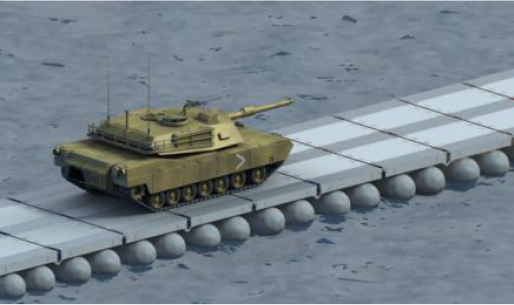
FIGURE 4-13 Artist’s conception of the LCMS in use by an M1 Abrams.
SOURCE: David A. Horner, Technical Director, Military Engineering Business Area, “ERDC Reduced Logistics R&D,” presentation to the committee on February 5, 2014.
________________________
14 An ISO container is a container that meets the specifications laid out by the International Organization for Standardization (ISO).
Recommendation 4-4. The Army should support or conduct research and development efforts to improve ramp interfaces, causeway connectors, causeway motions, crane heave compensation, and other components to permit operations in sea states of 3 or more.
Recommendation 4-5. The Army should monitor work to develop methods, systems, and/or procedures to create a lee or otherwise dampen waves and swell to reduce the sea state.
Offshore Petroleum Distribution System
The Military Sealift Command operates the USNS VADM K.R. Wheeler (Figure 4-14). Built in 2007, this vessel is 348 feet long and moves at 15 knots. It is designed to marry deepwater tankers to shore-based bulk fuel reception facilities. The Wheeler carries 8 miles of 8 in., metal-lined, flexible pipe on two 35 foot reels. Together with its 165 foot tender, the MV Fast Tempo, and two lighter, amphibious, resupply cargo vehicles, the Wheeler can deploy and be ready in 48 hours to pump two million gallons of fuel per day.
The Wheeler represents an important capability in support of expeditionary operations, particularly in the Asia-Pacific theater. Having only one of these vessels would seem to pose a significant operational risk to the sustainment of Army operations in certain settings, especially given the A2/AD threat to port facilities. Either having more than one of this type of vessel available or having suitable equipment kits (e.g., pipe on reels, pumps, generators) to enable the conversion of vessels such as tankers to this purpose might give the Army a much-needed sustainment capability.
Finding 4-8. The Military Sealift Command has only one offshore petroleum distribution system vessel. Without having port facilities accessible by tankers, the Army could be highly dependent on this one vessel. There is thus great risk to this capability from breakdown, damage, or enemy action.
Recommendation 4-6. The Army should press for the Navy and/or U.S. Transportation Command to procure additional vessels of this type, and for the acquisition of equipment in modular packages to rapidly convert tankers or other suitable platforms into offshore petroleum distribution system vessels.
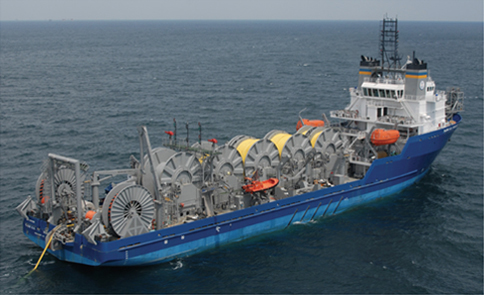
FIGURE 4-14 The USNS Wheeler. SOURCE: U.S. Navy, “MSC 2007 in Review,” http://www.msc.navy.mil/annualreport/2007/pm3.htm.
The use of standardized shipping containers is ubiquitous in international logistics. They provide efficient means to move, secure, and hold cargo. Army logistics efforts have faced challenges with the costs, use, storage, and retrograde of shipping containers. For instance, the Army at one point was paying large demurrage costs for shipping containers sitting empty and not returned to the companies that leased them to the Army. There are many ways to optimize the use of shipping containers and operations involving them. The committee believes that better use of containers offers the Army numerous avenues for cost and effectiveness savings. Appendix E provides a thorough discussion of the potential for such adjustments to current Army container use.
Once ashore, Army logistics will be dependent on Army systems. As noted previously in this report, convoy operations consume a great deal of manpower and place soldiers at risk. Some technologies could take people out of danger and increase the efficiency of logistics operations. The use of autonomous vehicle technologies, both ground and air, and standoff delivery technologies could help address the challenge of A2/AD environments. Autonomous convoys could be used to put fewer personnel into hazardous situations. Aerial technologies such as precision air drop and autonomous aerial vehicles could be used that would reduce the number of personnel in hazardous situations or avoid those situations entirely. Autonomy could be particularly useful in moving supplies the last tactical mile.
It has been posited to the committee that the use of autonomous ground vehicles could save weight and, therefore, fuel. However, so long as the vehicles are to be optionally crewed, all the components necessitated by the presence of humans will still have to be carried on board. Also, questions such as whether autonomous convoys would make softer targets, easier to destroy or seize, would have to be addressed.
Over the last 10 years there have been significant efforts by the Defense Advanced Research Projects Agency (DARPA), the U.S. Army Tank Automotive Research, Development and Engineering Center, and private industry to develop technologies that will allow vehicles to operate autonomously. These include a number of well-publicized success stories, such as the Lockheed Convoy Active Safety Technology (CAST) program, Mercedes Benz’s autonomous driving S500 class vehicle, and the Google self-driving car (Guizzo, 2011).15,16
Prior Autonomy Efforts Relevant to Logistics
In the mid-2000s DARPA established three challenges—two grand challenges and one urban challenge—to engage industry and academia in the development of autonomous vehicle technologies. The two grand challenges were focused on off-road autonomy. In the first challenge, held in 2004, no
________________________
15 Lockheed Martin, “Autonomous Mobility Appliqué System (AMAS),” http://www.lockheedmartin.com/us/products/amas1.html, accessed August 26, 2014.
16 Daimler, “Pioneering Achievement: Autonomous Long-Distance Drive in Rural and Urban Traffic: Mercedes-Benz S-Class INTELLIGENT DRIVE drives autonomously in the tracks of Bertha Benz,” September 9, 2013, media.daimler.com/dcmedia/0-921-614307-1-1629819-1-0-0-0-0-0-11702-0-0-1-0-0-0-0-0.html.
participant completed more than 7.4 miles of the 150 mile desert course. In 2005, the second grand challenge, 5 of the 23 competitors completed a 132 mile course in the dessert. In the final challenge, the urban challenge, held in 2007 in Victorville, California, 4 of the 11 vehicles in the final competition completed the 60-mile course within the 6 hour time limit. The results of the challenges demonstrated progress in the field. In fact, DARPA stopped funding these types of efforts, believing that private industry would continue to refine and improve the technology.
Recognizing the potential inherent in autonomous vehicle technology, the Army has undertaken a number of research and development (R&D) projects in an effort to understand the capabilities and limitations of autonomous vehicles. The CAST program was undertaken by the Tank Automotive Research, Development and Engineering Center to determine if convoys could be implemented using leader-follower technology. This technology relies on a trailing vehicle focusing on the vehicle immediately in front of it and following that vehicle in close proximity. A follow-on program, Autonomous Mobility Appliqué System (AMAS),17 is currently under way. This program builds on the success of CAST and is investigating how to implement autonomous technologies in an existing vehicle fleet by retrofitting the technology into existing vehicles to allow truck convoys in a military setting. The AMAS program is focused on three different kits, which could be procured from multiple sources and interface with one another through standard interfaces:
• A kit: sensors and software for autonomy;
• B kit: components to interface with the steering, braking, acceleration, and shifting controls; and
• C kit: a mission-specific platform that can be optionally installed on a vehicle.
Several demonstrations of the AMAS system have shown that the concept is achievable and the technology approach is viable. However, there are several challenges. These include the cost of the A kit and the B kit, which are high because items such as drive-by-wire capability and high-resolution sensors are not yet produced in sufficient quantity to have reached affordable price points. Another challenge is the use of active sensors (e.g., light detection and ranging) in theater, because they announce their location to all onlookers. Passive sensor technology exists to address this issue, but it is not as robust as active sensors across all lighting and weather conditions. The autonomous vehicle developer community widely believes that as private industry embraces autonomous capability, the sensors and hardware required for this capability will see significant cost reductions as well as enhanced capabilities.
In the commercial autonomous vehicle R&D community there are programs ongoing at over 25 companies building the core technologies needed for 360-degree awareness and to enable a vehicle to drive autonomously in a complex urban environment. The efforts by Google are the most widely publicized. The Google self-driving car is based on DARPA Urban Challenge technologies (Guizzo, 2011). It can drive autonomously on previously driven routes utilizing a high-precision digital map. The requirements for a map and the predriving of the route before the system can drive it autonomously obviously limit the applicability of this approach to military applications. The Mercedes self-driving S500 class vehicle has a number of onboard sensors that allow it to sense its surroundings and compare the results to a preinstalled three dimensional map to identify its location as well as potential conflicts. This information is used to provide automated driver assistance as well as automated driving.
As with all technology development efforts, there are still some limitations with each of these efforts. Cost is an issue as the hardware for autonomous operation often costs in excess of $100,000 per vehicle above the platform cost. Software costs are unknown as no developer of autonomous vehicles has provided any software-specific pricing. The most complex limiting factor is determining how to implement automation for the very complex scenarios that may occur only once every several thousand hours of operation. Consider that over an everyday driver’s lifetime, 99.9 percent of the situations
________________________
17 Lockheed Martin, “Autonomous Mobility Appliqué System (AMAS),” http://www.lockheedmartin.com/us/products/amas1.html, accessed August 26, 2014.
encountered are predictable and recoverable. However, there are very rare situations that a driver has not encountered before where intuition takes over. Intuition is a very complex thing to program into a computer.
Another developmental and implementation challenge is certifying autonomous vehicles as safe to test and operate. One of the current challenges facing the states that have passed legislation allowing autonomous vehicles on their roadways is how to evaluate and certify that they are safe enough to be on the public roadways. The U.S. Department of Transportation is starting to address this challenge. In order to have a successful testing and certification program, criteria need to exist against which to validate vehicle performance. To date, no set of criteria for the commercial application of autonomous vehicles has been developed by industry or by the federal or state governments. Nor has the Army documented the functional requirements for what it wants autonomous vehicles to achieve. This requirements process has to be in place before the overall effort required to implement autonomous technology can be thoroughly evaluated. The committee estimates that once requirements have been established, autonomous vehicle technology could be ready to use in rough terrain or unpredictable environments in 2-5 years with a properly funded and implemented R&D program.
Finding 4-9. Autonomous vehicle technologies offer a significant opportunity to automate military operations in order to improve logistics operations. They are ready to deploy in constrained settings with limited obstacles and established routes. They are not yet ready to deploy in operational settings with rough terrain or unpredictable routes. This capability could be achieved in 2-5 years, given a properly funded and implemented research and development program.
Recommendation 4-7. Autonomous vehicle technologies should be implemented in phases, starting with what is possible now using semiautonomous technologies such as leader-follower so that incremental improvements to logistics can be realized as the technology matures. Research and development should be continued to develop these technologies for use in challenging, unpredictable environments that are currently beyond their reach.
The European Union sponsored a program called Safe Road Trains for the Environment (SARTRE) that explored the dynamic formation of road trains (which, in this context, means what we call convoys in the United States), including both passenger cars and trucks, using autonomous technologies. The formation and operation of road trains along European highways has been successfully demonstrated.18 This program was a research program and has concluded, but it has not yet led to the operational use of autonomous technologies.
In both military (e.g., CAST) and commercial applications (e.g., SARTRE) the autonomous vehicle community has demonstrated that automated convoys are feasible, based on existing sensors and current technologies. However, fully automated vehicles that can navigate complex urban environments are not at the point where they could be reliably deployed without further R&D. Currently, commercial autonomous vehicles can successfully navigate in most normal driving conditions in good weather. The challenge is navigating in situations that rarely occur or that were not considered by the system developer during design. These efforts have been successful because convoys do not require elaborate 360-degree situational awareness. They use leader-follower technology, with following vehicles focused on a fiducial on the vehicle in front of them and maintaining pace with that vehicle. They are not concerned with traffic events to their sides or behind them because they are deploying in constrained environments and are not expected to interact with large numbers of manned vehicles with a number of different operational goals.
________________________
18 See “The SARTRE Project,” http://www.sartre-project.eu/en/Sidor/default.aspx, accessed August 26, 2014.
Applying Autonomy to Logistics
From the above discussion it can be seen that autonomous vehicle technology would seem to be ready to deploy in constrained, predictable operational environments, mostly where there are roads and established routes to be followed and where a number of technology efforts have met with success. However, developing a system that can address all possible conditions is still not feasible. This is why the states that are allowing the testing of autonomous vehicles still require a safety driver to be in the vehicle to take control from the computer if needed.19 Nevertheless, the committee believes the technology is robust enough to bring the following benefits to operations:
- Remove warfighters from high-risk tasks such as driving roads in hostile environments,
- Reduce the number of drivers required to move logistics materiel,
- Relieve warfighters from doing repetitive tasks, and
- Eliminate human errors due to factors such as fatigue.
When it comes to deploying autonomous vehicle technologies in a full range of military settings (e.g., rough terrain or unpredictable routes), however, there are technical challenges to overcome. Autonomous vehicles must be capable of operating in an environment where Global Positioning System systems have been degraded or blocked entirely. This means these vehicles need to have good systems capable of determining their location integrated into the vehicle platforms. Another challenge is the overall cost of the hardware; as noted above, many of the sensors widely used on autonomous vehicles are still very expensive because they are not produced in mass quantities. A vital component for any autonomous vehicle is the drive-by-wire system that provides the computer with the ability to control the steering, braking, acceleration, and gear shifting. While some new commercial vehicles have this built into the vehicle, existing Army vehicles would need an expensive retrofit to automate their functions. The use of active sensors (e.g., light detection and ranging) would need to be addressed as these sensors would probably not be acceptable for many in-theater operations.
Finding 4-10. Convoy operations are highly repetitious tasks that could utilize today’s existing autonomous vehicle technology to reduce manpower requirements and reduce risk to the vehicle operators.
Recommendation 4-8. The Army should implement secure leader-follower vehicle technology (a vehicle follows a fiducial on the vehicle in front of it), which does not require 360-degree awareness and can be done with low-cost sensors using Autonomous Mobility Appliqué System technology.
While not an autonomy technology, another concept used in states and countries that have open terrain with minimal topography is known as a road train (distinct from the term’s meaning in the SARTRE discussion above), which allows freight to be moved more efficiently by connecting multiple trailers to a single tractor. This concept, which emulates some of the properties of autonomous convoys, is
________________________
19 California is leading the country in establishing rules for autonomous vehicle testing (California Department of Motor Vehicles, “DMV Adopts Autonomous Vehicle Testing Rules,” News Release, May 19, 2014, https://www.dmv.ca.gov/portal/dmv/detail/pubs/newsrel/newsrel14/2014_34). Florida and Nevada are also writing rules for this. They are widely expected to parallel California’s rules.
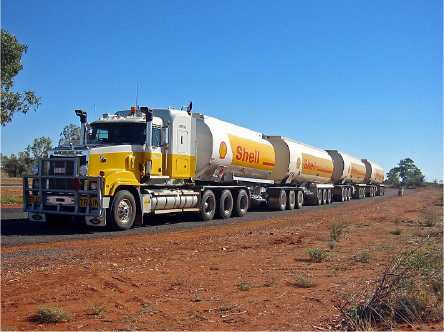
FIGURE 4-15 An example of a road train. SOURCE: “Road Train Australia” by Thomas Schoch - Own work at www.retas.de/thomas/travel/australia2005/. Licensed under Creative Commons Attribution-Share Alike 3.0 via Wikimedia Commons, http://commons.wikimedia.org/wiki/, File: Road_Train_Australia.jpg#mediaviewer/File:Road_Train_Australia.jpg.
limited to relatively flat environments that have simple roadway geometry without a lot of tight turns. The road train concept could be useful for long-distance logistics operations. An example of a road train is shown in Figure 4-15.
Over the last 5 years there have been efforts in the Department of Defense community to explore the use of autonomous vehicle technologies to provide logistical support to the last tactical mile, as well as to explore ways to lighten the load of the warfighter by providing autonomous load-bearing capabilities.20 The Marine Corps has conducted several R&D programs to develop core technologies to support these capabilities. The Ground Unmanned Support Surrogate (shown in Figure 4-16)21 was an R&D program to develop a low-speed autonomous vehicle to carry warfighter payloads as well as support medical evacuation. The U.S. Marine Corps Small Unit Mobility Enhancement Technology program22 focused on utilizing low-cost sensor technology to provide a logistics connector from the forward operating base to the squad in the field.
________________________
20 The last tactical mile is the last leg of the distribution process, from the forwardmost base to the deployed forces in the field.
21 Ground Unmanned Support Surrogate information available at www.torcrobotics.com/case-studies/guss, accessed August 26, 2014.
22 Small Unit Mobility Enhancement Technology (SUMET) Program – Funded by ONR, information available at http://www.swri.org/4org/d10/isd/ivs/sumet.htm, accessed August 26, 2014.
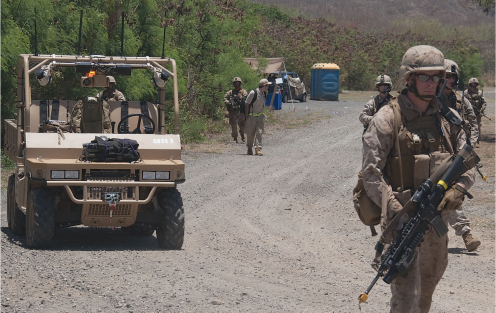
FIGURE 4-16 Ground Unmanned Support Surrogate undergoing testing.
SOURCE: U.S. Marine Corps photo by LCpl Ronald W. Stauffer, http://www.navy.mil/view_image.asp?id=131302.
The Army’s Dismounted Soldier Autonomy Tools program developed technologies to assist with efforts to lighten the load that must be carried by soldiers, which ranges from 60 to120 lb depending on the assignment, and to provide off-road mission support (Wright, 2013). To assist with delivery and support along the last tactical mile the Army R&D community is working on the squad mission support system (SMSS).23 SMSS is an unmanned vehicle based on a turbodiesel-powered, high-mobility, six-wheel, all-terrain vehicle capable of carrying 1,000 lb of payload. The SMSS concept is to carry enough of a load to support a squad, conduct autonomous movement over rough terrain, and provide amphibious capability for crossing rivers and marshes in order to improve combat readiness while assuring resupply channels and the ability to evacuate casualties. Each of these programs has resulted in platforms that have been tested with the warfighters. The initial results suggest that they provide an attractive option for additional R&D investment. Some of these efforts could include the development of more cost-effective sensors, more cost-effective drive-by-wire components, and studies on how to more efficiently integrate autonomous vehicle technology into the warfighters’ activities.
Finding 4-11. Autonomous vehicle technology could be utilized to lighten the load dismounted warfighters currently must carry. Also, resupply operations in the last tactical mile could be efficiently performed by autonomous vehicles to reduce the risks to supply vehicle operators.
Recommendation 4-9. The Army should develop and field autonomous platforms to provide logistical support in the last tactical mile by assisting in carrying supplies and equipment to the warfighter in the field.
________________________
23 SMSS information available at www.lockheedmartin.com/us/products/smss.html, accessed August 26, 2014.
Aerial autonomy is another area of automation that needs to be considered. Many of the limitations of ground-based logistics support, such as the complexities of terrain and the need to predrive routes, are removed simply by using an aerial vehicle. Many of the A2/AD risks faced by ground vehicles can also be avoided or partially mitigated, although new risks open up for air vehicles. Operational costs and limited payloads may limit broad applicability of aerial autonomy technology, but for logistics operations in highly complex terrains, the technology is worth investigating.
In the last several years, work has been undertaken to use unmanned air systems to support logistics operations. In 2009 DARPA initiated the Transformer program, which was focused on the development and demonstration of a prototype hybrid ground-air vehicle that could provide flexible and terrain-independent support for logistics, personnel transport, and tactical support for ground units.24 The initial motivation for Transformer was to develop a system that could master transiting complex terrains and countering improvised explosive devices that affected traditional ground-based transportation. Initially the Transformer program was a design competition between multiple organizations. In 2013 the Aerial Reconfigurable Embedded System (ARES) concept being developed by Lockheed Martin, and Piasecki Aircraft was selected to move forward as the Transformer demonstration project.25 ARES is a vertical takeoff and landing delivery system that will be unmanned and is expected to support multiple payload configurations from a common airframe. ARES is being developed by the Lockheed Martin Skunk Works team and was in its third and final phase of research and development as of February 2014. Artist’s concepts of ARES are shown in Figure 4-17.
Another example of a potential aerial logistics support tool is the Lockheed Martin K-MAX helicopter, which is capable of both remote-controlled and unmanned operations.26 The K-MAX program is under development by the Marine Corps and is designed as a power lift helicopter capable of cargo delivery. It is capable of delivering 6,000 lb of cargo at sea level and more than 4,000 lb at 15,000 feet.27 The K-MAX began a 6 month testing period in Afghanistan, with the initial unmanned resupply mission having been performed on December 17, 2011.28 Following nearly 3 years of successful operations in which more than 4.5 million pounds of cargo were delivered over thousands of missions, the K-MAX has been returned to the United States as part of the retrograde from Afghanistan.29 In March 2014 Sikorsky, under the Manned/Unmanned Resupply Aerial Lifter program with the U.S. Army, demonstrated its capability on its existing fleet of Sikorsky autonomous research aircraft being operated remotely by a pilot on the ground.30 Sikorsky has developed a platform-independent flight control system that was initially developed for commercial offshore oil industry applications and has been refined for military operations. Sikorsky plans to install autonomous capability onto a Blackhawk helicopter and demonstrate the capability in 2014.
________________________
24 Aerial Reconfigurable Embedded System (ARES) information available at http://www.darpa.mil/Our_Work/TTO/Programs/Aerial_Reconfigurable_Embedded_System_(ARES).aspx, accessed August 27, 2014.
25 ARES information available at www.lockheedmartin.com/us/products/ares.html, accessed August 27, 2014.
26 K-MAX information available at www.lockheedmartin.com/us/products/kmax.html, accessed August 27, 2014.
27 Ibid.
28 Information on Unmanned K-MAX Operational in Afghanistan is available at http://www.aviationtoday.com/rw/military/unmanned/Unmanned-K-MAX-Operational-in-Afghanistan_75637.html, accessed August 27, 2014.
29 Information on Lockheed Martin’s Unmanned K-MAX Cargo Helicopter Team Returns from Deployment with U.S. Marine Corps in Afghanistan is available at http://www.lockheedmartin.com/us/news/pressreleases/2014/july/140724-lm-unmanned-kmax-cargo-helicopter-team-returns-from-deployment.html, accessed August 27, 2014.
30 There are several Sikorsky autonomous research aircraft.
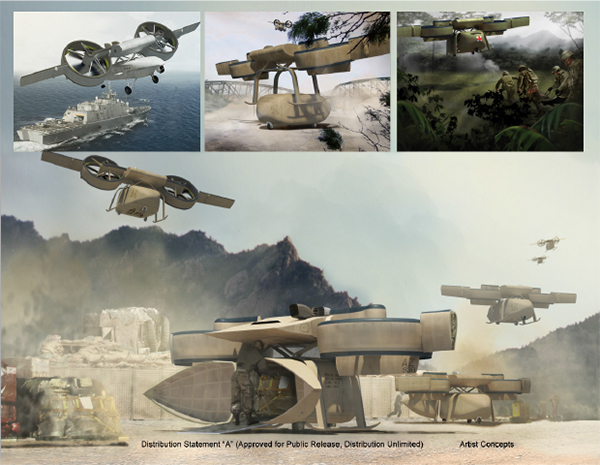
FIGURE 4-17 Artists’ renderings of ARES. SOURCE: Defense Advanced Research Projects Agency, Tactical Technology Office.
Finding 4-12. Unmanned and remote-controlled aerial assets have been utilized by the Marine Corps to provide logistics support.
Recommendation 4-10. The Army should work with the Marine Corps to undertake research and development on a common autonomous aerial support capability for logistics.
Precision air drop, a technique that involves air-dropped cargo guiding itself to a landing zone, has been used operationally. It is distinguished from conventional air drop in that the latter drops entirely unguided packages. Precision air drop offloads some portion of Army sustainment to the Air Force and reduces the number of Army vehicles that have to be used to deliver supplies to deployed forces. The main classes of supply air dropped in Afghanistan in 2013 were food, water, and fuel. From an Army-centric logistics viewpoint, the reduction in the number of vehicles used reduces both the fuel and maintenance demands associated with operating those vehicles and thus can have a positive logistics impact.
This technique has been used successfully on a large scale in Afghanistan. The joint precision airdrop system (JPADS), shown in Figure 4-18, uses an airborne guidance unit, electromechanical steering actuators, and a steerable canopy to guide payloads to their landing points. JPADS is a family of systems offered in the following versions:
- Microlight: 10-150 lb;
- Ultralight: 250-700 lb;
- Extra light: 700-2,400 lb;
- Light: 5,001-10,000 lb; and
- Medium: 15,000-42,000 lb.
All of these versions have been developed. The JPADS family of systems allows for drops from up to 25,000 ft and 25 km offset.31 From 25,000 ft the JPADS can hit a soccer-field sized landing zone within a 23 km radius cone of coverage.32 One aircraft dropping from one location can deliver payloads to multiple locations on the ground.33 Work is also ongoing to develop a helicopter sling load system to work with JPADS. This system can carry 32 low-cost, low-altitude airdrop systems, which are expendable air drop systems designed to open at 100-500 ft altitude. It could be modified to carry up to eight container delivery systems. It has been developed to interface with UH-72, UH-60, CH-47, and CH-53 helicopters and has been demonstrated on UH-72, CH-47, and CH-53 helicopters. One benefit of this system is that the Army does not have to depend completely on the Air Force for air drop assets.34 The helicopter sling is shown in Figure 4-19.
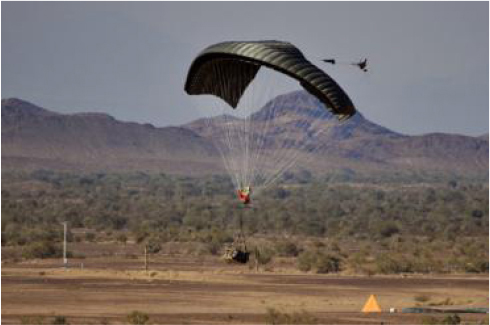
FIGURE 4-18 JPADS. SOURCE: Richard Benney, NSRDEC, “Aerial Delivery Overview to Support NRC Force Multiplying Technology for Logistics Support to Military Operations,” presentation to the committee on February 5, 2014.
________________________
31 Richard Benney, NSRDEC, “Aerial Delivery Overview to Support NRC Force Multiplying Technology for Logistics Support to Military Operations,” presentation to the committee on February 5, 2014.
32 Keith Bowman and Daniel Schreiter, Precision Airdrop Program Office, AFRL, “AFRL Precision AirDrop (PAD) Update,” presentation to the committee on February 5, 2014.
33 Richard Benney, NSRDEC, “Aerial Delivery Overview to Support NRC Force Multiplying Technology for Logistics Support to Military Operations,” presentation to the committee on February 5, 2014.
34 Keith Bowman, and Daniel Schreiter, Precision Airdrop Program Office, AFRL, “AFRL Precision AirDrop (PAD) Update,” presentation to the committee on February 5, 2014.
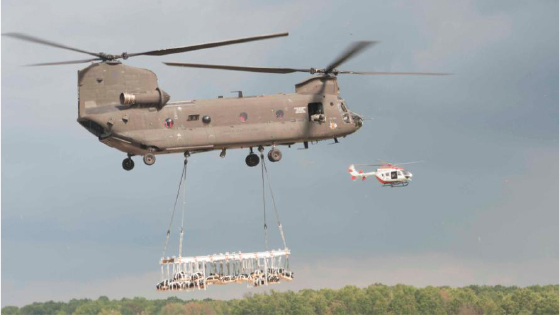
FIGURE 4-19 Helicopter sling for delivering cargo by JPADS, during testing. SOURCE: Keith Bowman and Daniel Schreiter, Precision Airdrop Program Office, AFRL, “AFRL Precision AirDrop (PAD) Update,” presentation to the committee on February 5, 2014.
JPADS eliminates some reliance on ground resupply, removing trucks and personnel from convoy duty and thereby mitigating challenges such as improvised explosive devices. In addition to the logistics benefits, this capability allows resupply to more easily keep pace with expeditionary forces on the move. There is a desire to increase precision in the future. The committee was briefed that precision air drop within a forward base’s wire could be possible within 10 years. A high-altitude, low-opening JPADS option is also under consideration. The goal would be to provide more standoff and get the dropping aircraft above most ground threats.35
The committee was also briefed about two potential but unfunded air drop programs. One is tactical aerial delivery for squads or small units on the move. The purpose of this program would be to develop a technology to deliver 200-500 lb of cargo to squads or small units. This would simplify logistics in the last tactical mile, reduce the burden on the Army logistics system, and reduce soldier burden. It is envisioned that a squad or small unit might be able to secure drop on-demand through a Nett Warrior application.36 While this would largely leverage Air Force assets, it could also be used with Army air assets. The proposed program schedule envisions a 5-year effort to advance the system from technology readiness level (TRL) 5 to TRL 8.37
The other potential program is heavy air drop for payloads of at least 60,000 lb. The purpose would be to deliver bulk supplies and even combat vehicles directly to the point of need. The program would include multiple scalable, modular systems and technologies, including advanced low-velocity, high-altitude, low-opening approaches. The proposed program schedule envisions a 5 year effort to advance the system from TRL 5 to TRL 7. A proof of concept was carried out in 2004. A Stryker armored
________________________
35 Richard Benney, NSRDEC, “Aerial Delivery Overview to Support NRC Force Multiplying Technology for Logistics Support to Military Operations,” presentation to the committee on February 5, 2014.
36 Nett Warrior is an information technology system to assist unit leaders with situational awareness and mission command. Additional information is available at www.peosoldier.army.mil/docs/pmswar/Nett-WarriorPoster-061512.pdf, accessed November 7, 2014.
37 Richard Benney, NSRDEC, “Aerial Delivery Overview to Support NRC Force Multiplying Technology for Logistics Support to Military Operations,” presentation to the committee on February 5, 2014.
gun system vehicle was successfully dropped from a C-17. No development work is currently ongoing or envisioned at this time.38
Finding 4-13. Precision air drop of sustainment materiel could significantly reduce the demand for ground-based resupply of forward areas. It could take trucks off the road and reduce personnel risk. A helicopter-based Joint precision air drop system capability is being developed that could both reduce Army dependence on other Service assets and expand the number of assets that can be used in a sustainment role, adding flexibility to the sustainment mission.
Recommendation 4-11. The Army should adopt precision air drop for sustainment to forward areas as widely as practical. It should also pursue a helicopter-borne Joint precision air drop system capability to expand its overall sustainment options and capabilities.
CBO (Congressional Budget Office). 2007. Sea Basing and Alternatives for Deploying and Sustaining Ground Combat Forces. www.cbo.gov/sites/default/files/cbofiles/ftpdocs/82xx/doc8284/07-05-seabasing.pdf.
DA (Department of the Army). 1999. Reception, Staging, Onward Movement, and Integration. FM 100-17-3. Washington, D.C.: Headquarters, Department of the Army.
Defense Industry Daily. 2013. “Whatever Floats Your Tank: the USN’s Improved Navy Lighterage System.” http://www.defenseindustrydaily.com/whatever-floats-your-tank-the-usns-improvednavy-lighterage-system-02251/.
DSB (Defense Science Board). 2003. Defense Science Board Task Force on Sea Basing, August. http://www.acq.osd.mil/dsb/reports/ADA429002.pdf.
Guizzo, E. 2011. “How Google’s Self-Driving Car Works.” IEEE Spectrum. Posted October 18. http://spectrum.ieee.org/automaton/robotics/artificial-intelligence/how-google-self-driving-carworks.
Jackson, J. 2009. Mobility Capabilities and Requirements Study 2016 Accreditation Report. Volume 1: Summary. Alexandria, Va.: Institute for Defense Analysis.
Polmar, N. 2013. Naval Institute Guide to the Ships and Aircraft of the U.S. Fleet, 19th Edition (Naval Institute Guide to the Ships & Aircraft of the U.S. Fleet). Annapolis, Md.: Naval Institute Press.
Resio, D., and J. Fowle. 2010. “Ship-to-shore causeway system for military and emergency operations.” Sea Technology Magazine. January. http://www.sea-technology.com/features/2010/0110/ship_to_shore.html.
Wright, B. 2013. U.S., allies test robots at Fort Benning. Army Times. July 18. www.armytimes.com/article/20130718/NEWS04/307180024/U-S-allies-test-robots-FortBenning.
Young, MAJ J. 2011. Lessons from Rhino LZ: How the Afghanistan invasion changed combat airlift. Armed Forces Journal. November 1. www.armedforcesjournal.com/lessons-from-rhino-lz/.
38 Ibid.


























